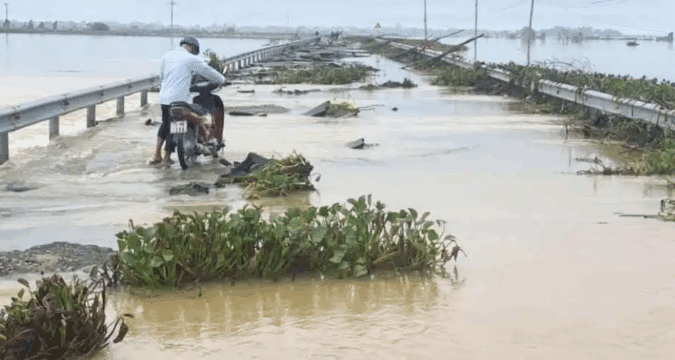
Nguyen Ba, a 63-year-old farmer in Quang Phuoc commune, stood silently before his flooded field in Hue, central Vietnam, where 3,000 square metres of freshly sown rice now lay submerged.
“We poured all our savings into this crop. Now it’s all underwater,” he lamented in a choked-up voice. “It’s heartbreaking.”
A father of three and grandfather of two said Nguyen had never witnessed flooding during June, a month historically known in the area for scorching heat and drought.
“This is completely unprecedented,” he added. “June is supposed to be dry and blistering. This kind of flooding belongs to the typhoon season in autumn, not the middle of summer.”
The unprecedented flooding was triggered by Typhoon Wutip which hit central Vietnam between June 10 and 14, leaving at least nine dead, several missing and thousands marooned.
The changing weather patterns in Vietnam indicate the country’s vulnerability to climate change impacts, according to climatologists and weather experts
For Nguyen and many farmers like him in Quang Phuoc, the latest disaster is more extreme than ever. Earlier this year, he experienced a series of failed harvests caused by prolonged cold rains and abnormal windstorms.
He borrowed 25 million dong [HK$7521] to hire labour, rent machinery, and buy fertilizer and pesticides, only to see the investments go down the drain.
“Now, with our crops destroyed again, the debt is crushing,” he lamented.
The loss has had severe impacts on family life as well. Nguyen is afraid he will be unable to pay for his daughter’s university tuition fee of 13.5 million dong [HK$4,061].
“We are not just losing crops, but we are losing the future we’ve tried to build for our children,” he noted.
In nearby Huong Tra, 56-year-old Phan Xuong suffered a catastrophic loss when three tons of caged fish were swept away by the surging Bo River. Losses exceeded 450 million dong [HK$135,380].
“We had to abandon the cages and run for our lives,” the river fisherman said. “There was nothing we could do but watch the river carry our livelihood away.”
June is supposed to be dry and blistering. This kind of flooding belongs to the typhoon season in autumn, not the middle of summer
Nguyen Ba
In past decades, central Vietnam’s flood season typically spanned from October to December. But in recent years, those weather patterns have shifted dramatically.
“Never in my life have I seen such torrential rain and strong winds in June. It’s usually scorching, with temperatures climbing past 40°C,” Phan said.
With three children in university and high school, he fears for his family’s future. “How will we survive this? How can we afford their education now?”
The changing weather patterns in Vietnam indicate the country’s vulnerability to climate change impacts, according to climatologists and weather experts.
The latest typhoon brought record-breaking rainfall to central provinces stretching from Ha Tinh to Quang Ngai, submerging over 3,500 homes and devastating nearly 90,000 hectares of rice paddies and aquaculture farms, according to the Department of Dike Management and Disaster Prevention.
The deluge has amplified the economic hardships of rural communities already grappling with erratic weather patterns and shrinking margins for survival.
Meteorologists and climate experts say these events are no longer isolated anomalies, but part of a broader, more perilous trend
Meteorologists and climate experts say these events are no longer isolated anomalies, but part of a broader, more perilous trend.
“Typhoon Wutip, the first storm to strike Vietnam this year, brought record June rainfall to the central provinces—levels unseen in living memory,” said Nguyen Huy, a weather and climate change specialist.
“This is deeply troubling, as it signals a collapse in traditional seasonal boundaries,” he noted.
He warned that such events—extreme in intensity and unpredictable in timing—are likely to become more frequent and devastating in the coming years.
“We must brace for a future where the old rules no longer apply,” he said.
Church leaders in affected areas are also sounding the alarm and mobilising relief efforts.
I don’t know how we’ll get through this. Everything we build keeps getting washed away
Phan Xuong
Father Paul Hoang Thanh Hung, who serves the Huong Loc Sub-parish in the mountainous district of Nam Dong of Quang Tri province, said local peanut fields, which are just weeks from harvest, were completely inundated.
Torrential rains triggered landslides that buried roads, gardens, and homes in surrounding villages.
“Many families remain stranded,” Hung said. “We are reaching out to assess agricultural losses and plan emergency support for affected communities, particularly among ethnic minorities who are most vulnerable.”
Vietnam experienced a cascade of climate-related disasters in 2024. Five typhoons—Prapiroon, Soulik, Trami, Yinxing, and the ferocious Yagi lashed the country.
Yagi, the most powerful storm in three decades, left an estimated 330 people dead or missing, damaged 280,000 hectares of land, and caused financial losses of up to US$3.5 billion.
That year, southern Vietnam saw widespread extreme heat for 47 consecutive days. The city of Dong Ha recorded a blistering 44°C, Vietnam’s highest temperature since 1976.
On average, Vietnam contends with 7–10 storms or tropical depressions annually, causing approximately 300 deaths and damaging 250,000 hectares of agricultural land, according to government statistics.
For rural families like Nguyen’s and Phan’s, these statistics are not abstract — they are existential.
“I don’t know how we’ll get through this,” Phan said quietly. “Everything we build keeps getting washed away.” UCAN








